Once you find a shark tooth the next step is to identify what type of shark it is from. Some large teeth like the Megalodon and great white shark are easy to identify. There are over 500 species of sharks and smaller shark teeth can be more difficult to identify. Looking at the jaws of sharks gives a good idea about the different shapes of teeth there can be for the upper and lower jaws. A single shark can actually have very different shaped teeth depending on the location within the jaw.
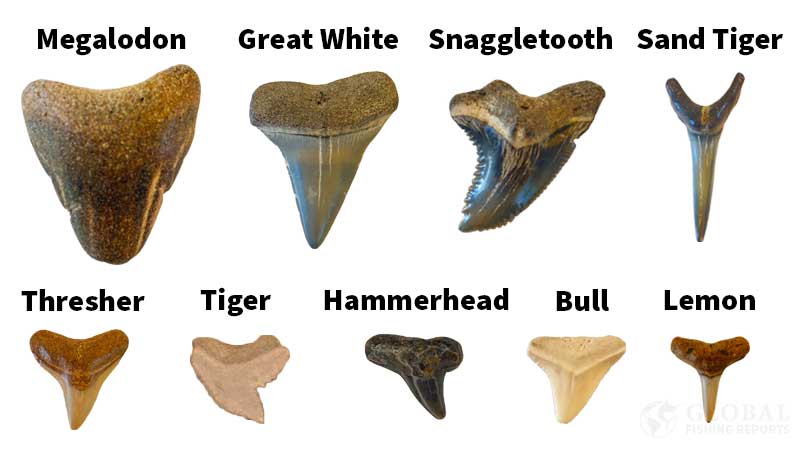
The photo above shows the teeth of the megalodon, great white, snaggletooth, sand tiger, thresher, tiger, hammerhead, bull, and lemon shark. These are what most people would consider the textbook shape teeth for each type of shark. However, even within these basic sharks, there are older extinct species that were very similar. So doing more research can provide insight into the type of shark tooth and the age of the shark tooth.
Tiger Shark
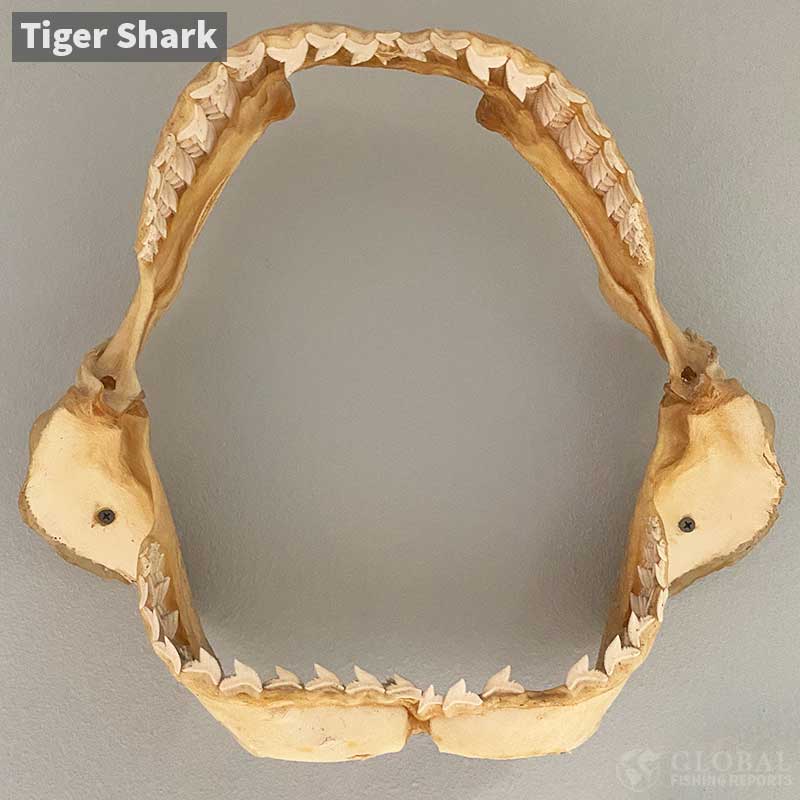
Tiger sharks are large sharks that can grow to be over 16 feet long and weigh over 1,700 pounds. These sharks are found in warm waters in Florida, on both coasts of Mexico, Central America, South America, Africa, Australia, and off the coast of South Asia.
The teeth of a tiger shark are very unique and have a similar shape on the upper and lower jaw. A wide base and long edge make the teeth excellent for cutting through fish. Below the point of the tooth is a lower serrated section of teeth which allows for additional cutting. Tiger sharks are known for feeding on lots of different types of prey including fish, sea birds, dolphins, adult sea turtles, sharks, rays, seals, sea lions, and even whales.
In the photo above you can see many rows of teeth behind the primary front row. When the shark bites into prey the teeth can dislodge and teeth from the back rows move up to replace the front teeth. This helps ensure the shark always has strong sharp teeth to help catch and eat whatever type of prey they encounter.
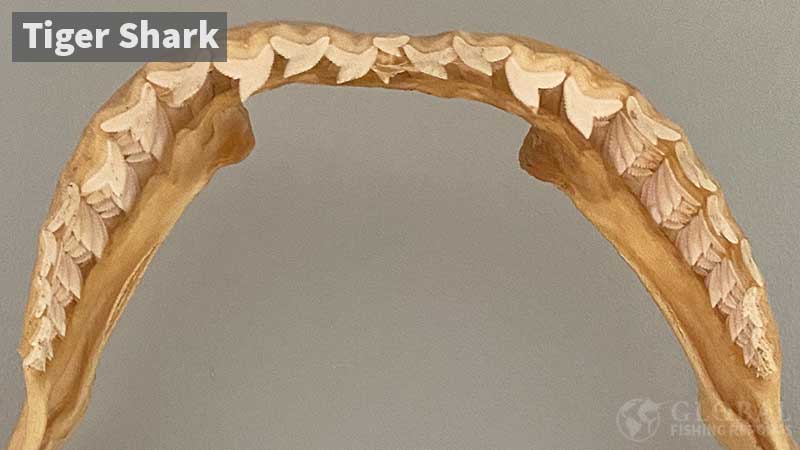
The photo above shows the upper jaw of a tiger shark. While all the teeth have the same unique shape the front teeth are much large and get smaller toward the back of the jaw. There are several extinct species of tiger sharks with similar but slightly different shapes and serrated edges. Some of these species such as the G. Latidens lived in the Eocene epoch over 33 million years ago.
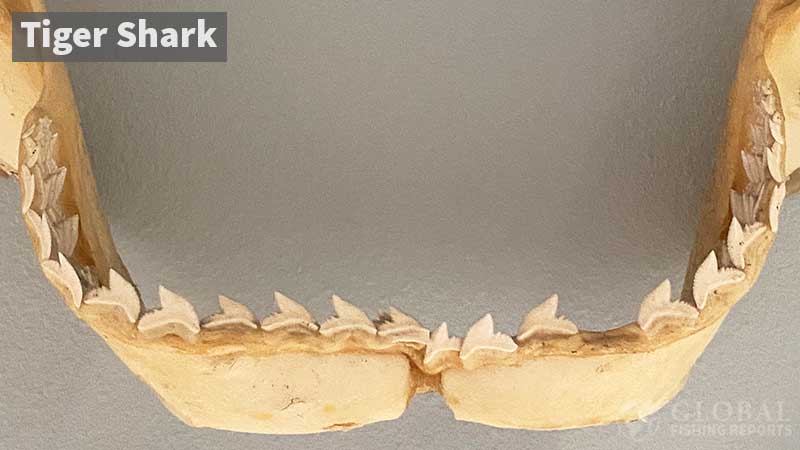
A tiger shark’s lower jaw can be seen above. The teeth are slightly smaller than the top teeth and point in the opposite direction. This different direction of the top and bottom teeth allows the shark to cut into its prey like a saw that cuts as the shark shakes its head. The overall jaw shape is very wide even for a shark which helps grab and eat large prey.
Lemon Shark
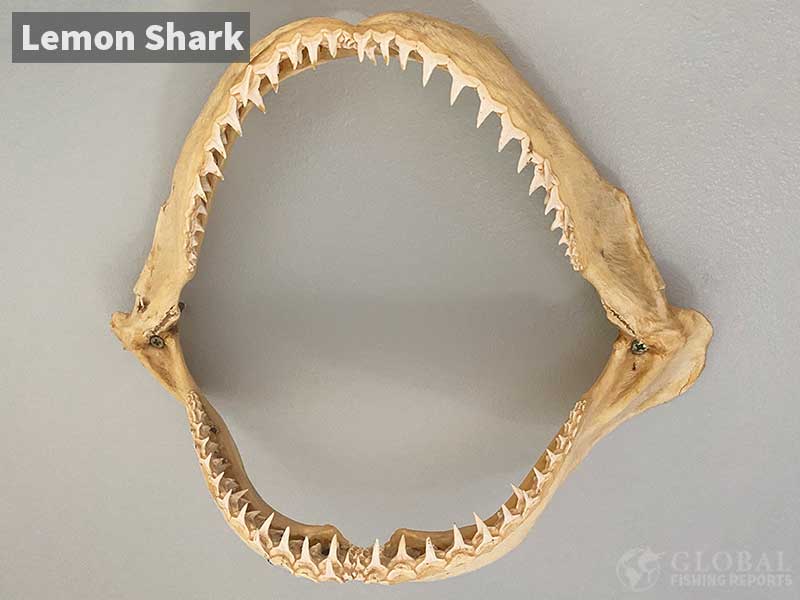
Lemon sharks are average size sharks that can grow to be over 11 feet long and over 400 pounds. A lemon shark has a classic t shape tooth with a sharp point. This is a very common shark tooth to find on the beaches in southwest Florida. Lemon sharks are very prevalent in the Florida Keys and in the Gulf o Mexico.
The teeth on the bottom jaws of many other sharks including the bull shark, dusky shark, blacktip shark, silky shark, bonnethead, sandbar shark, and others look very similar to lemon shark teeth. For this reason, many people find teeth and call them lemon shark even though they very well may be from a different type of shark. The teeth of a lemon shark are fairly thin, curve inward slightly, and have a wide base.
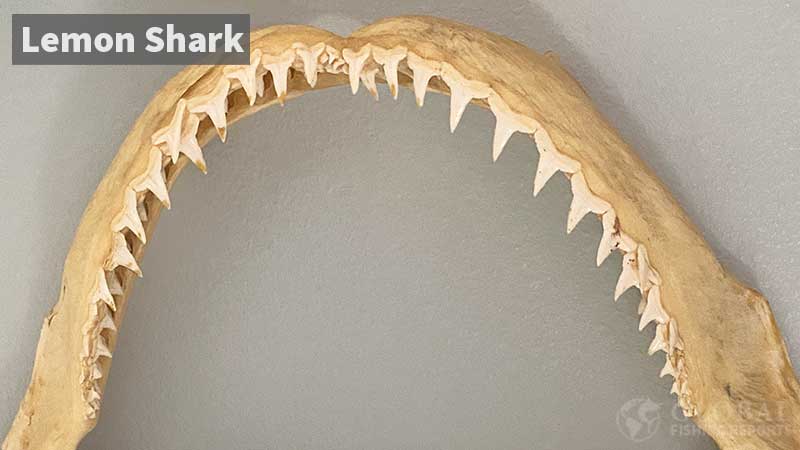
The top jaw of a lemon shark has teeth that are slightly larger than the bottom teeth but have the same shape. There are many rows of teeth behind the front row as well. These are not typically exposed but are under the skin and in cartilage. The sharp pointy teeth of a lemon shark cut into the fish or prey as the shark bites down. Near the wide base of the tooth, the two top edges are also sharp and slant back slightly. These are also cutting surfaces that allow the lemons shark to make clean bites.
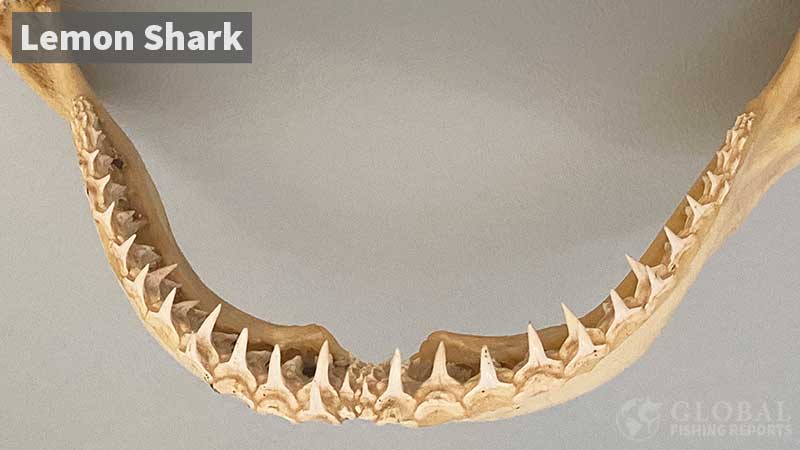
On the bottom jaw of a lemon shark, the teeth look similar to many other sharks. This could mean the species are closely related or that sharp pointy teeth are advantageous for catching and eating fish. Behind the front rows, there are many other rows of teeth ready to replace any that are lost when feeding.
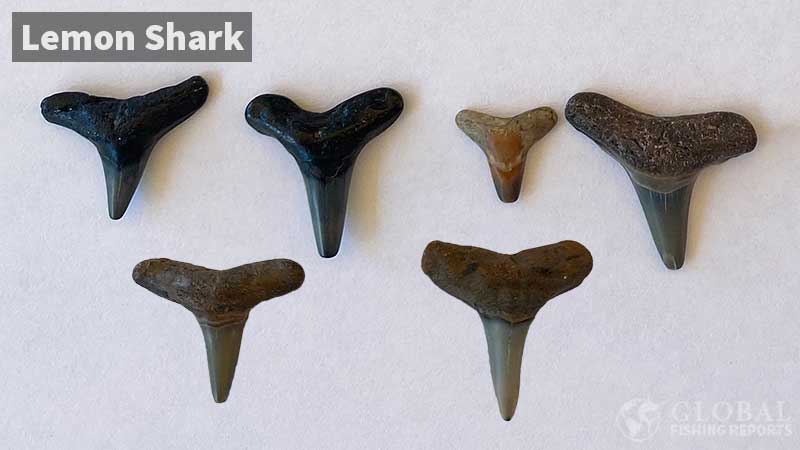
The teeth shown above are fossilized lemon shark teeth. These were found at the beach in South Florida. The color of the tooth varies depending on the type of sediment it settled in when it was being fossilized. It takes over 10,000 years for a shark to become fossilized and shark teeth can be found that are over 30 million years old.
The exact shape of the tooth varies depending on whether it was from the top jaw or lower jaw. The shape can also vary depending on how the tooth is worn. Since this shape is common for bottom teeth of other sharks it is actually difficult to say for certain these are lemon shark teeth. They do have the characteristic size and shape of lemon shark teeth though.
Bull Shark
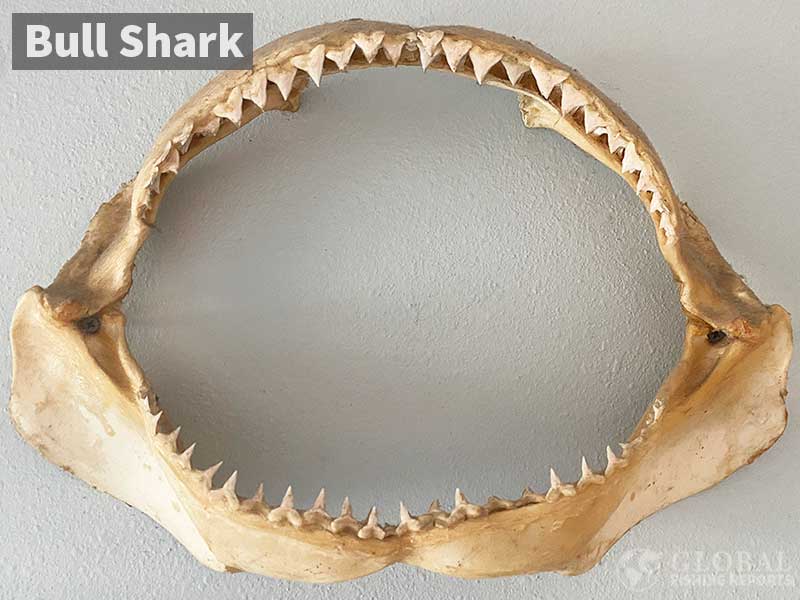
Bull sharks are large sharks that can be over 600 pounds and 12 feet long. The mouth of a bull shark is wide similar to a tiger shark. Bull sharks are a top predator in the ocean feeding on other fish, sharks, stingrays, birds, turtles, and even dolphins. These sharks are commonly seen by snorkelers and divers on reefs and shipwrecks. Bull sharks tend not to be pelagic fish and stay in shallower waters less than 500 feet deep.
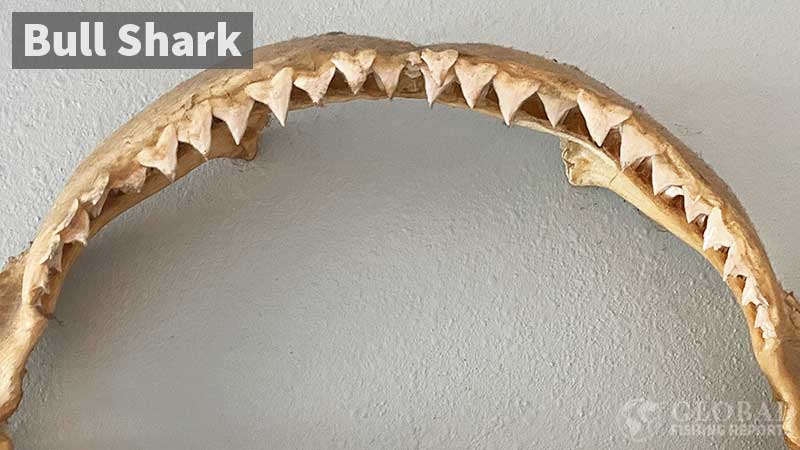
The top teeth of a bull shark are pretty unique with one side slanting down evenly and the other side of the tooth slanting at a shallow angle and then midway going to a sharper slanting angle. Some teeth near the center of the jaw slant evenly on both sides and resemble great white shark teeth.
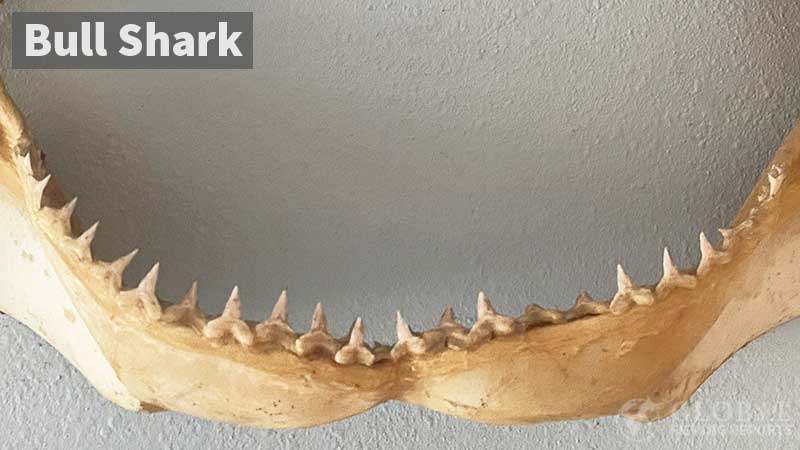
The bottom jaw of a bull shark has teeth that look similar to many other sharks. When you find a bottom bull shark tooth at the beach it is difficult to say that it is a bull shark tooth for sure. It also looks like a lemon shark tooth or a blacktip shark tooth.
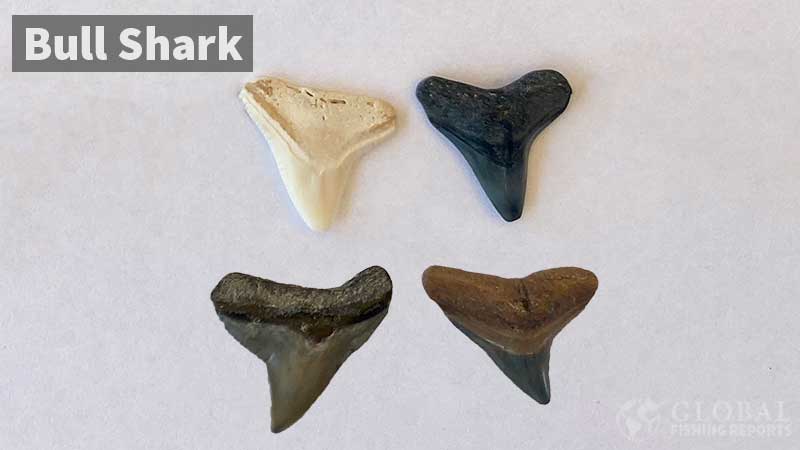
The teeth above are from the top jaw of a bull shark. On the upper left, the tooth has not been fossilized yet and is still white in color. The other teeth are fossilized and all look slightly different. All the teeth have the same overall shape which is how they can be identified as bull shark teeth.
Dusky Shark
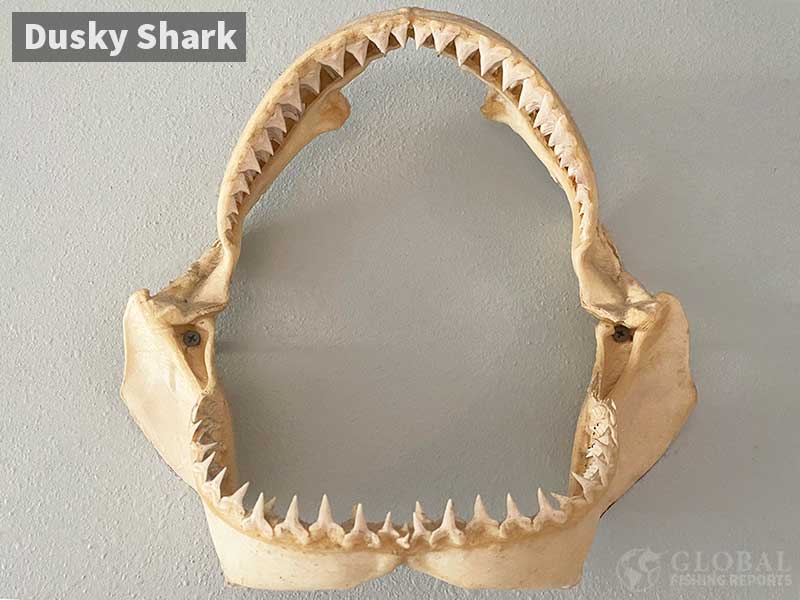
Dusky sharks are classic-looking sharks that are typically found offshore in pelagic waters. These sharks can go in shallow waters near the coast as well but this is less common. When fishing offshore in the keys for tuna and bonito it is common to have one or more dusky sharks following the school. Dusky sharks are a protected species of shark and must be released if caught.
These are large sharks that can grow to 14 feet in length and weigh over 750 pounds. Dusky sharks can be found off the east coast of North and South America from Maine to southern Brazil. It is important that these sharks are protected because they do not reach sexual maturity until 20 years old. So fishing can put the species at risk even more so than other sharks.
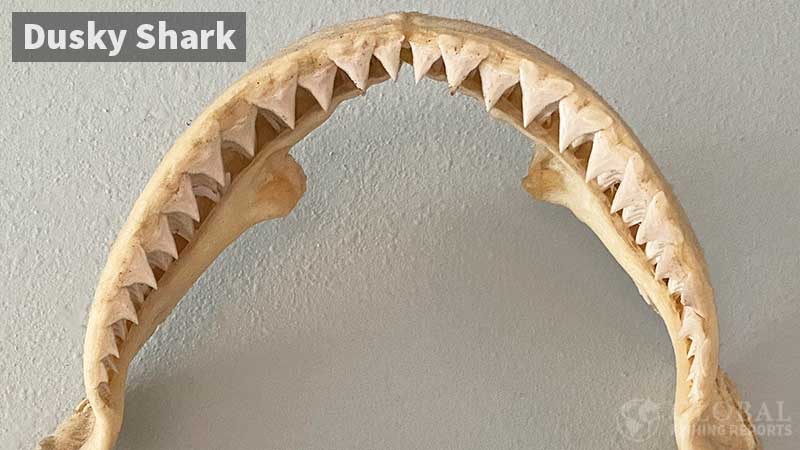
Above is the top jaw of a Dusky shark. The teeth are very similar in shape to bull sharks. It is possible that this is a bull shark jaw. However, the jaw is not a wide oval shape like a classic bull shark jaw. In the front, the teeth have a triangle shape similar to a great white. Moving out toward the side of the jaw the teeth change shape and have the classic bull shark or dusky shark tooth appearance.
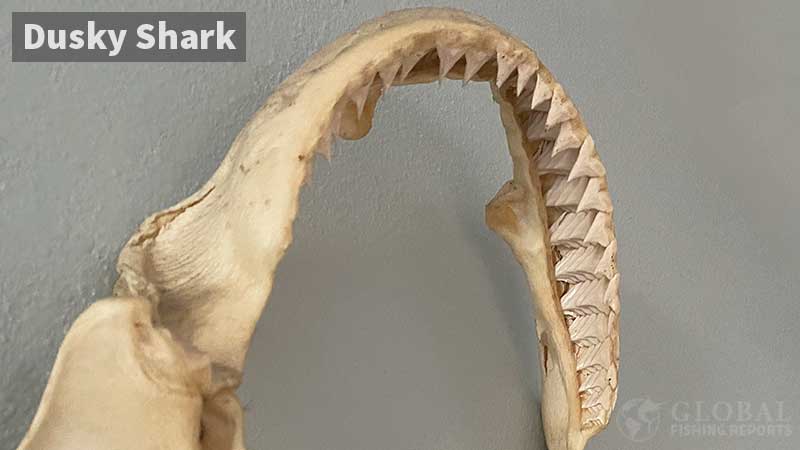
Looking at the side view of the jaw you can see 7 or more rows of almost full-size teeth. On a shark typically only the first row is exposed. If one of the front teeth falls out when feeding then a tooth from the back row moves forward. This makes it so the shark always has sharp white teeth.
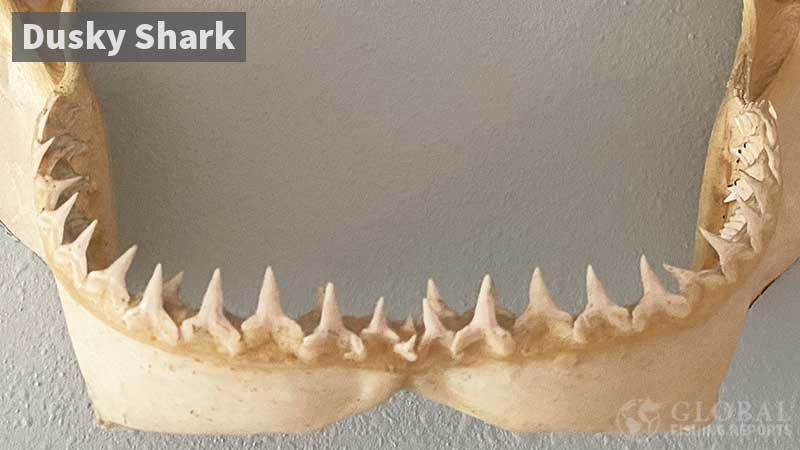
The bottom teeth of a dusky shark are sharp and pointy similar to bull sharks, lemon sharks, and blacktip sharks.
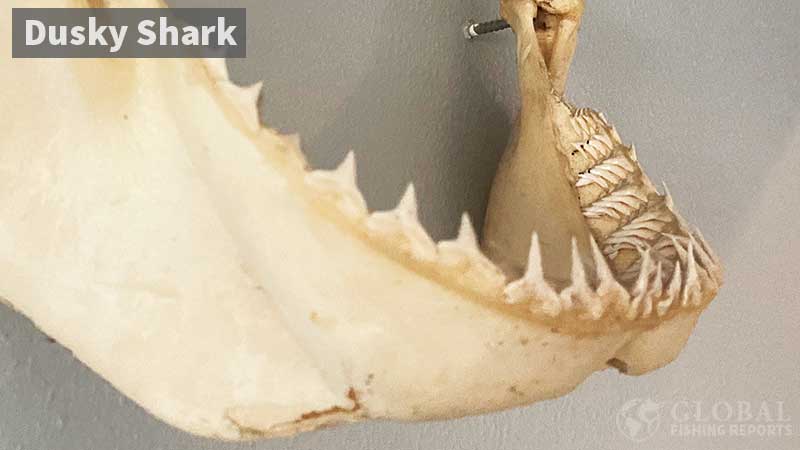
On the bottom jaw, there are 6 distinct rows of teeth. The teeth in the very front are positioned vertical ready to be used. Each row behind the front row is angled back slightly. If the front tooth is lost the next tooth in the row will slide forward and be positioned vertically. Because sharks have so many teeth and there were so many sharks alive in the past 30 million years it is actually not difficult to find shark teeth at the beach.
Megalodon Shark
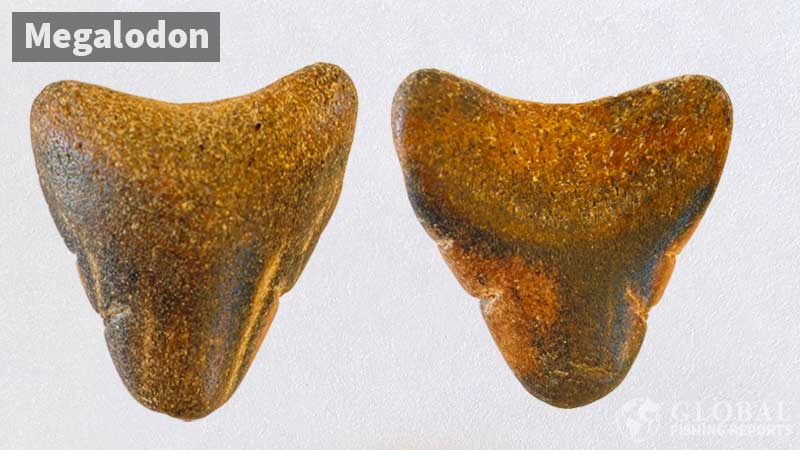
Megalodon sharks when extinct over 3 million years ago. So when you find a Megalodon shark tooth you know that it is really old and a unique find. The exact size of these sharks can only be estimated. Maximum size estimates range from 52 feet long and 105,000 pounds to 67 feet long and 227,000 pounds. This would be nearly twice the weight of an average humpback whale. The average size of a megalodon is estimated to be closer to 34 feet long.
Just like all other sharks, the teeth of megalodon varied based on age and location within the jaw. A megalodon tooth has been found that was over 7-inches in length. However, most megalodon teeth are not this large. If you find a tooth is the shape of a great white and is slightly larger and thicker it is probably a megalodon tooth. Many people seem to find well-preserved large teeth. However, these teeth are over 3 million years old so finding ones with a more aged appearance is also common. Especially if they are found on a beach.
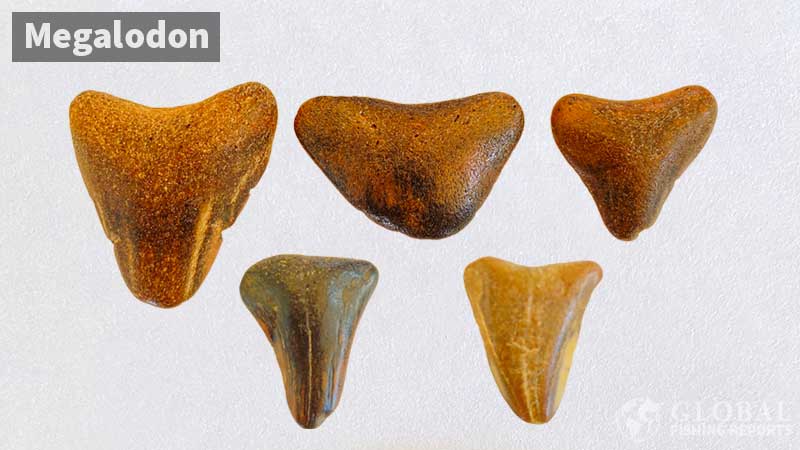
All of these teeth were found in South Florida on or near the beach. The teeth have the characteristic size and shape of a megalodon tooth. Being in the surf can slowly wear away the tooth. So when looking on a beach do not expect to always find a perfect tooth but one that is worn down but is still the shape of a large tooth.

In the photo, I am standing next to a large Megalodon tooth that is on display. This is what most people think of when they think of a megalodon tooth. If these teeth did not exist many people probably would not even believe that a shark this large ever existed.
Great White Shark
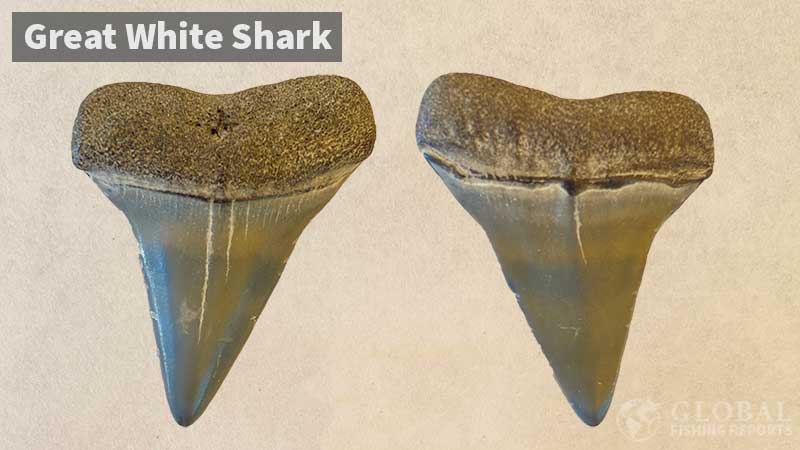
Most people are familiar with the great white shark. These sharks can grow to be 20 feet and length and weight up to 5,000 pounds. The IGFA world record catch for a white shark is 2,664 pounds. In the united states, it is against the law to target great white sharks when fishing. Sometimes they are caught when shark fishing for other types of sharks though.
Great white shark teeth are a highly desired fossil to find. The upper and lower teeth of a great white have a similar shape. Some people might confuse the very front teeth of a bull shark with a white shark. The way to tell the difference is that white shark teeth have sharper angles.
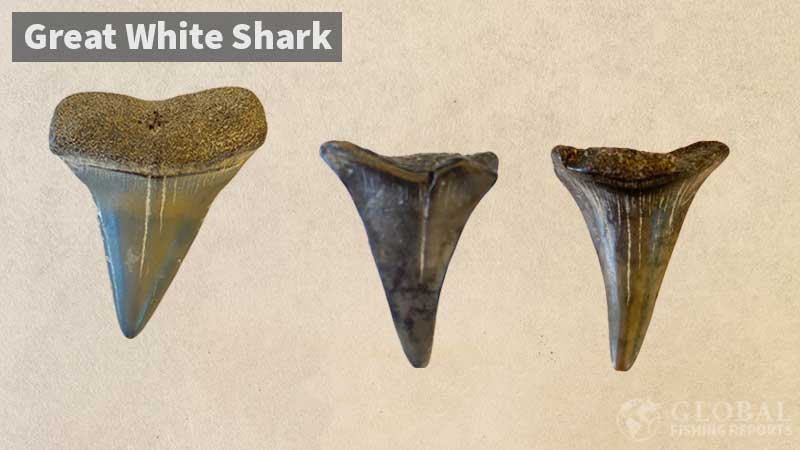
The teeth above are from great white sharks or their ancestors. The two teeth on the right are from a prehistoric white shark known as a narrow white or Carcharodon H astalis. This would mean the shark teeth are between 3 million and 20 million years old.
Snaggletooth Shark
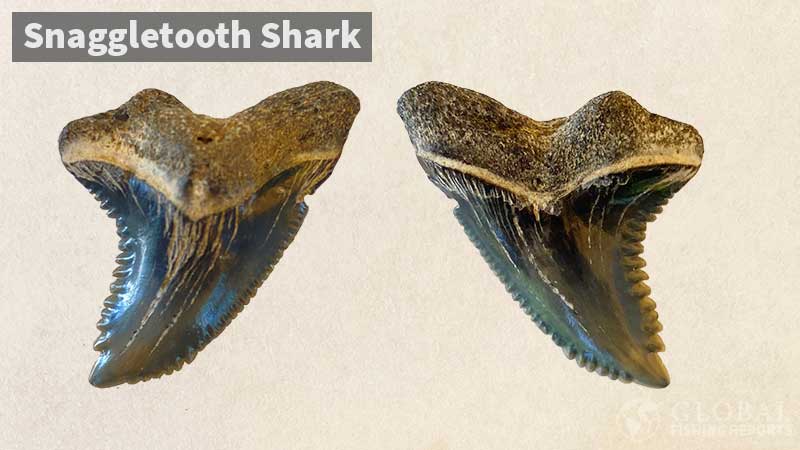
I actually thought the snaggletooth shark was extinct but I was wrong. These sharks are not found in North America but do live on the east coast of Africa, Australia, and in waters of the coast of South Asia. The rage may have extended into the USA as this tooth was found in south Florida. This is a smaller shark that is typically 4-8 feet in length which is surprising as the tooth in the picture is quite large. Perhaps millions of years ago this type of shark was larger.
Snaggletooth shark teeth are very distinct in shape as the edge of the tooth is both curved and serrated. The teeth in the front middle jaw of the shark are not this shape and come to a sharp point. However, the teeth on the lower jaw near the base keep the typical snaggletooth shark shape.
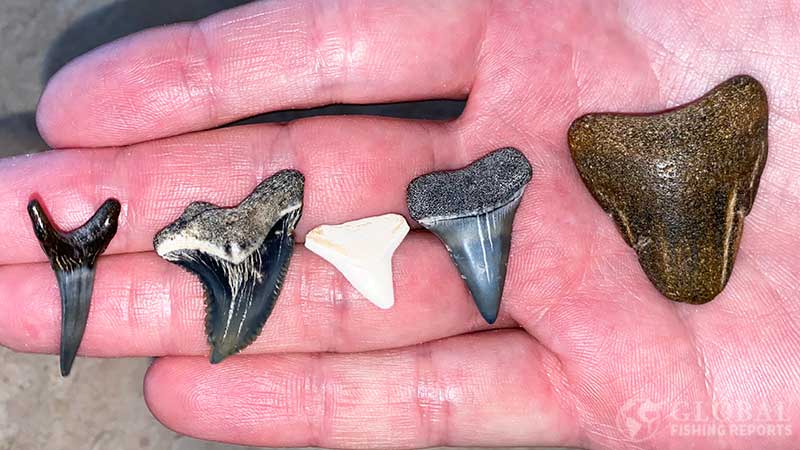
In the photo, I am holding 5 different shark teeth. From right to left the teeth are from a megalodon, great white, bull, snaggletooth, and sand tiger shark. The snaggletooth shark tooth is surprisingly large for a shark that has a max length of 8 feet. Also notice that the bull shark tooth has not been fossilized even though it was found at the beach.
Hammerhead Shark
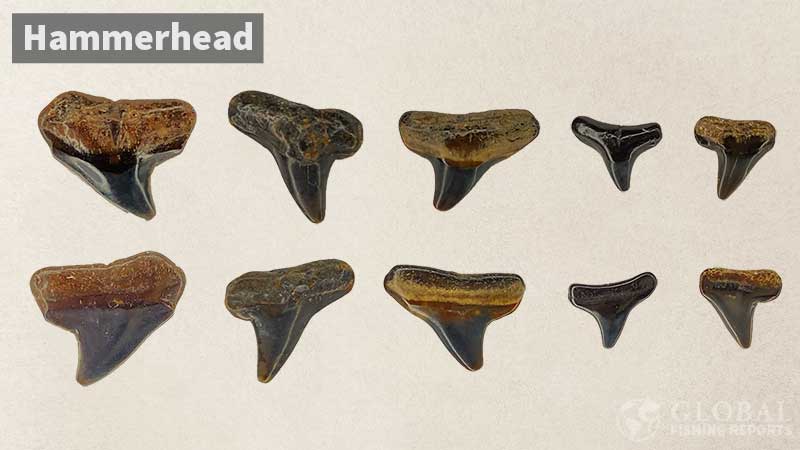
In the picture above the top row is the front of the hammerhead teeth. The bottom row is the back of the same teeth. The great hammerhead sharks can grow to be over 19 feet long and weigh over 1,200 pounds. Large great hammerhead sharks are known for eating stingrays, tarpon, and even other sharks.
Even though the shark is large the teeth are actually quite small. The shape of a hammerhead tooth can vary but they all have the same general shape. One side of the tooth has a long slant that curves into a point. The other side has a much sharper near verticle slant with a concave bend. There are different species of hammerhead including the great, smooth, small eye, scooped, scalloped, and winghead shark. Each species’ range is size and teeth shape are slightly different which is another reason for the various shapes of hammerhead teeth.
Thresher Shark
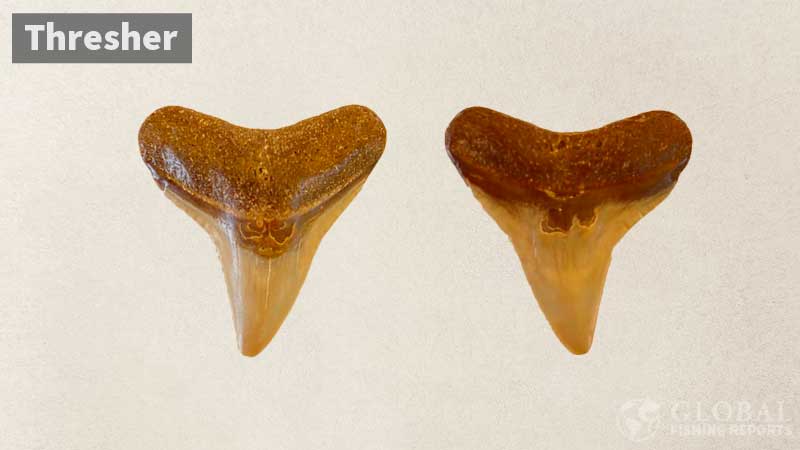
The thresher shark is known for its large tail which is actually the caudal fin. These sharks can grow up to 750 pounds and have a fork length of over 15 feet long. The caudal fin can be almost the length of the shark making the total length near 30 feet. A tooth from a thresher is similar in shape to a bull shark tooth. Where the tooth comes to a point on a thresher shark it is slightly curved and the top of the tooth is more round rather than flat.
Other Fossils
Turtle Shell
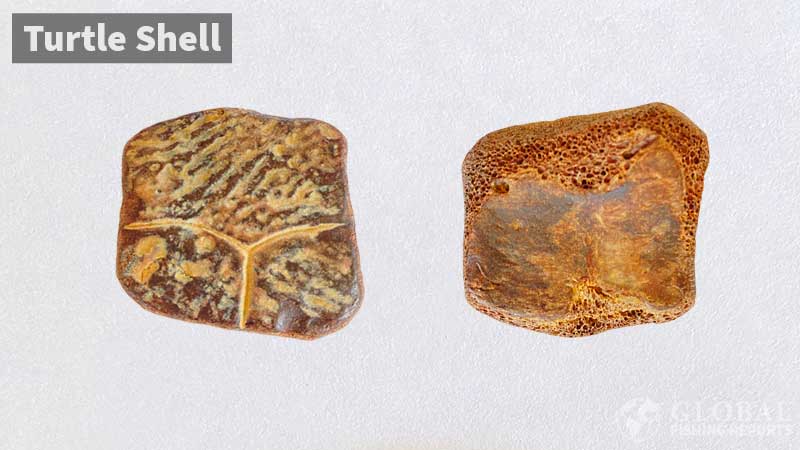
When looking for shark teeth it is common to find many other fossils as well. The picture above shows a piece of a sea turtle shell. Sea turtles have been around for around 110 million years so it is not uncommon to find fossilized shell material. In the picture, the left side shows the top of the shell and the right image shows the bottom of the shell.
Pufferfish Mouth plate
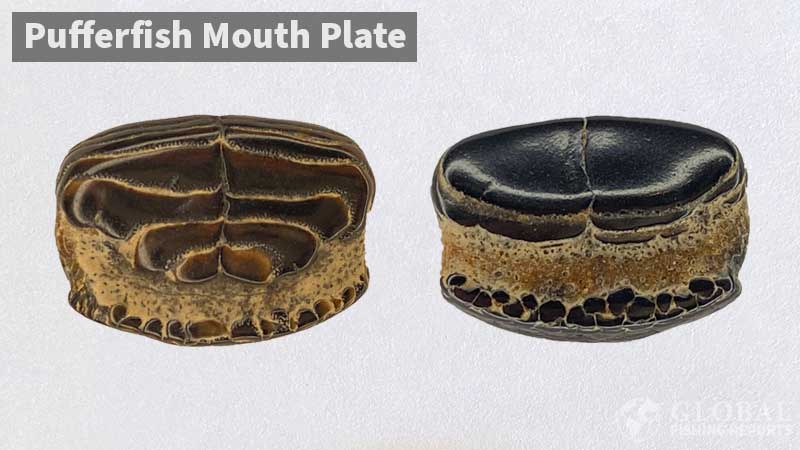
The picture above shows a pufferfish mouth plate. When looking at the mouth plate it is initially confusing as to the orientation of it relative to the fish. This would basically be the top or lower jaw of the fish. The left image is the inside of the mouth the right image is the outside. The teeth are located along the front which in this case is the bottom.
There are over 193 species of pufferfish so the mouth plate size and shape will vary. Other fish that have mouth plates include burrfish, parrotfish, and sheepshead.
Finding Fossils
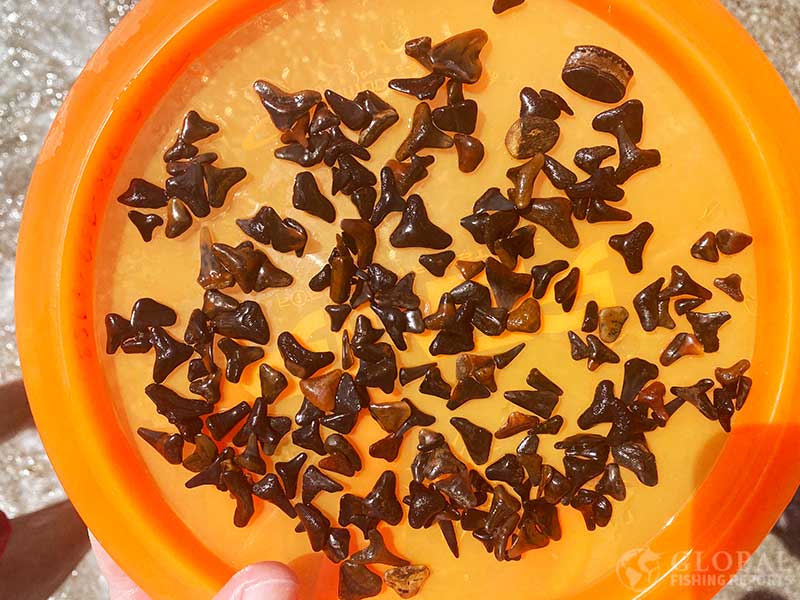
The photo above shows over 100 shark teeth as well as a pufferfish mouth plate. These were all found on a beach in Florida. I wrote a separate article on how to find shark teeth. On a recent trip to the beach, we averaged over 30 shark teeth per person every hour we spent looking. We were looking in the surf so many of these teeth are worn down but they are shark teeth.
Captain Cody has worked on charter fishing boats in the Florida Keys, Virgin Islands, and Alaska. Growing up in Pennsylvania Cody has also done extensive freshwater fishing including bass fishing tournaments. Cody strives to provide detailed information about the best fishing gear and tactics to help both novice and experienced anglers have a more productive and enjoyable time on the water. Cody also has a background in aerospace engineering and neuroscience but really only takes pride in being good at one thing and that is fishing!
